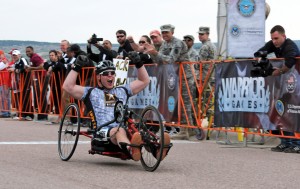
MSG Ron Prothero, who is stationed at Warrior Transition Unit, Fort Sam Houston, Texas, practices swimming laps during the 2013 Team Army Warrior Games cycling and swimming selection clinic. The selection clinic was conducted January 07-12 at Fort Bliss, Texas. (Photo by Patrick Cubel)
By Emily Anderson, WTC Stratcom
As the Warrior Games steadily approaches, more than 180 wounded, ill, and injured Soldiers and Veterans from across the U.S. and Germany are training at various training and selection clinics in hopes to be selected as an athlete for the Army’s team.
“We looked good last year and had quite a few successful athletes in many of the sporting events, but how we looked last year versus how we look now is completely different,” said MSG Jarrett Jongema, Adaptive Reconditioning Branch Noncommissioned Officer in Charge. “Different in that we have tried to build a more balanced, yet competitive team across all of the sporting events.”
During the 2013 Warrior Games, slated for May 11-17 in Colorado Springs, Colorado, athletes will compete in sitting volleyball, wheelchair basketball, swimming, cycling, track and field, archery, and competitive shooting with hopes of being awarded a gold, silver, or bronze medal.
“It’s great to see a Soldier or Veteran who has never tried one of these sports to come to the clinics, learn about it, go back home and practice, then come back determined to do better than their last try-out,” Jongema said. “They come back to each clinic with a higher caliber of motivation as well as improved results with their various scores, times, or distances.”
The training clinics are preparing the Soldiers and Veterans not only to compete for the Army during Warrior Games, but give them a chance to explore different reconditioning activities that they have not tried before.
“These clinics are more than just about making the team,” Jongema said. “We are trying to teach our Soldiers and Veterans about the different types of adaptive reconditioning activities because they could help in the recovery process.”
“The part that separates these clinics from other Adaptive Sports and Reconditioning events is that they are competitive in nature first, with the therapeutic and recreational aspects coming in second and third,” he added. “This changes the vibe in the air a little knowing that the people sitting in the room with you are competing for the same spot on team Army as you.”
The final round of training and selection clinics will take place the last week of February through the third week in March, and team selection announcement is tentatively planned for the first of April.
While everyone who tries for the team will not be selected – there is a 50 team member limit for each service during the Warrior Games – athletes are receiving specialized one-on-one training from experienced coaches, many who are U.S. Paralympics competitors or medal winners.
“Not only do we have top-notch competitors, but the coaches’ reputations speak for themselves,” Jongema added. “We are determined to select and compete with only those who put forth the efforts and really give it their all.”
For more information about Warrior Games visit the U.S. Army Warrior Transition Command Road to Warrior Games page or the U.S. Paralympics website.
Keep checking back for more updates as the road to Warrior Games continues.










